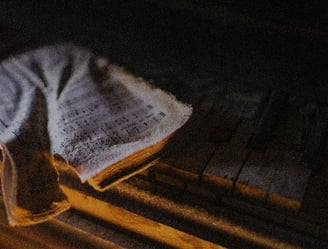Researching Unknown Melodies: Forgotten Masterpieces in the History of Music
Discover forgotten musical gems across cultures – from Baroque symphonies to Irish folklore and Maori instruments. Dive into Laptop Folk's modern fusion.
ABOUT MUSIC
11/28/20232 min read


The world of music is an endless ocean where waves of sounds carry countless undiscovered treasures. Among the great names and popular compositions, mysteries are hidden in little-known masterpieces of music history. Let's explore some specific examples of these unknown gems.
Forgotten Melodies of the Baroque Era
In the realm of classical music, there are talented composers whose works were unjustly left in obscurity. One such figure is Jan Dzius, whose symphonies, though unrecognized in their time, now captivate listeners with their depth and sophistication. Exploring his music places us in a world where each note seems to tell its own story, and every symphony demands thoughtful listening, revealing new nuances with each encounter.
Unknown Folklore Traditions
Ireland, known for its stunning nature, also boasts unique stories woven with sounds and melodies. Hungarian violinist and composer Miklós Scheller contributed to enriching Irish folklore, revealing through his creativity not only classical motifs but also the warmth of the Irish soul reflected in every note.
Mysterious Sounds of Ethnic Instruments
The Maori, the indigenous people of New Zealand, left the world not only with natural beauty but also with a unique musical legacy. The instrument taonga, crafted by skilled hands from wood, became not just a musical instrument but also a symbol of a deep connection with nature and their own history. Each note is not just a melody but a reflection of the spirit of the tribe and their perception of the surrounding world.
Forgotten Genres and Their Pioneers: Laptop Folk
In the contemporary era, a captivating musical genre emerges – laptop folk or electronic folk. Representatives such as Tune-Yards, Björk, and Philip Glass blend the unique features of traditional folk with modern electronics, creating a magical sound that bridges the past and present.
Conclusion
Entangled in the archives of musical history, these forgotten melodies and unknown masterpieces should be regarded as treasures awaiting discovery. They not only embellish our understanding of musical heritage but also open new perspectives for revitalizing the past, giving these enchanting sounds a second chance at glory in the world of music. May this exploration serve as a catalyst for listeners to uncover and appreciate the forgotten masterpieces deserving of our attention and gratitude.
Copyright © 2022 Synergy. All rights reserved.
Join Our Music Community
GET UPDATES IN YOUR MAILBOX
